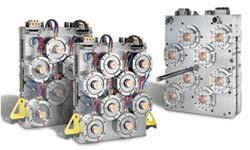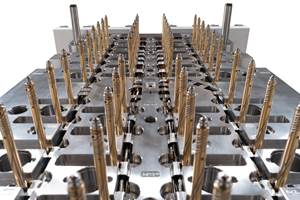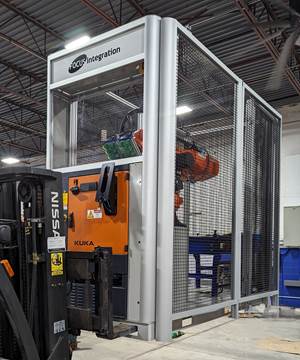Sustainability Raises the Stakes for Mold Performance
OEM demands for lightweight packaging are creating design challenges for toolmakers.
Sustainability is driving a lot of business decisions about product design, especially in packaging where a high use of plastics coupled with the large proportion of disposables has created a perfect storm of pressure from consumers and regulators to reduce the environmental footprint of containers. OEMs and retailers are responding by mandating reductions in the amount of material used in packaging, a move that affects moldmakers and the tools they build.
The main technique for materials reduction is lightweighting, which usually means thinwall construction. Moldmakers report that OEMs and other end-users are seeking on average cuts of 5 to 15 percent in the amount of plastics used in injection molded containers.
“Everyone was unconcerned for years about heavier parts as long as products did what they wanted,” says Jerry Seidelman, Sales and Marketing Manager at Tech Mold Inc. (Tempe, AZ). “Now they are looking to cut whatever they can.”
One example of how sustainability is affecting container design is a bottle for noncarbonated water developed by Sidel (Norcross, GA). Called NoBottle, the 500-milliliter (17-ounce) container uses 9.9 grams of polyethylene terephthalate—38% less than a conventional PET bottle of the same size. Despite its extreme lightweighting, it runs on Sidel’s high-speed filling lines, and uses shape-memory resin technology to maintain its form during pre-filling operations.
Rethinking Mold Performance
Thinwalling raises the bar considerably when it comes to mold fabrication. Toolmakers have to deal with a range of engineering and design considerations relating to resin flow, injection pressure, core and wall-section shifts, alignment and cycle-to-cycle consistency over millions of parts.
Toolmakers must meet these needs with molds engineered for higher levels of cavitation so OEMs can continue to control manufacturing costs through ever-higher production volume. As a result, single-face molds with 64, 96 and 128 cavities, and 2-, 3- and 4-level stack molds with up to 512 cavities, are more common.
Sustainability isn’t only materials reduction—it is also measured in the amount of resources used in shipping packages from plants to distribution centers and stores. Round packages are probably the easiest to mold but have a downside in transport, storage and display optimization (so-called cube efficiency), since they take up more space than square and rectangular containers. In fact, even without lightweighting, square and rectangular containers and other packages shaped to nestle firmly against each other help reduce the environmental footprint of packaging, especially for retail giants like Wal-Mart.
“These packages require fewer cartons for shipments than round containers, so you can consolidate trucks and use less fuel for shipping,” says John Plut, Marketing and Sales Manager at Top Grade Molds (Mississauga, ON, Canada). “You may not save much in plastics, but you will in other operations.”
As a result, more containers are likely to be designed with shapes conducive to cube efficiency, another factor that will affect mold-build requirements.
Most of these changes are here to stay. Not only will sustainability remain an important business issue, there is no sign that OEMs are willing to give back the cost savings achieved from reduced materials use, especially after the run-up in resin prices of the last several years. Most packaging resins are now posting lower prices and should continue to do so through at least the first quarter of 2009. But as Seidelman notes, “Even though prices are coming down, the focus on lower costs isn’t going to be lost.”
Holding Precision Tolerance
While there are many factors to consider in building molds for thinwall containers, two stand out: achieving extremely tight dimensional tolerances and balancing the ratio of flow length to average wall thickness (L/T).
Most moldmakers say they are holding tolerances of as little as +/- 0.0002 inch in high-cavitation tools for thinwall containers. Reasons for this, apart from wall thickness, include the need to assure that cavities, cores, flow channels, valve gates and other critical components align perfectly during high-speed and high-pressure injection cycles. Thinwall containers typically require molding pressures of 30,000 to 35,000 psi and up to twice as much clamp tonnage as before they were lightweighted. Injection machine sizes range from 300 to 1,000 tons.
“There is a lot of explosive force from the injection unit,” notes Jordan Robertson, General Sales Manager at StackTeck (Brampton, ON, Canada). “A mold must have excellent alignment features and robustness to endure these fast cycles and long runs, and to last for years.”
As an example of how critical precision specifications are to quality production, Seidelman notes that if one side of a cavity wall is even 0.0005 inch thicker than the other side, injection pressure could cause a core shift and produce a 5 to 10% deviation in wall thickness.
“When you talk about the wall thickness of these parts, you don’t talk dimensions, you talk percentages,” says John Nelson, Senior Project Engineer at UFE Inc. (Stillwater, MN). “If you’re talking about a 1.5-mil wall and you’re off 0.0015 of an inch, that’s one thing, but if you’re talking about a 0.75-mil wall, your margin for error percentage-wise is cut in half. As that wall gets thinner, the percentage of tolerance you can use gets smaller, so your accuracy has to be much greater.”
Fill speeds, additionally, are decreasing, with some as low as 0.1 second. “Speed is everything,” adds Nelson. “Material for thinwall containers must be injected quickly because the flow front is so thin it will freeze off otherwise.”
Moldmakers with experience in the extreme precision and quality standards needed for these applications generally claim few problems in meeting these requirements. Most, in fact, report developing much of their equipment and major mold components like hot runner systems to meet such specifications.
At Tech Mold, for example, Seidelman says the company uses Self-Correcting Manufacturing (SCM) software that was developed in-house. Designed for automated cells that machine steel or cut electrodes, SCM is a closed-loop system that measures surfaces and critical dimensions during machining according to a zero-tolerance model. It compares the performance of a CNC machine to the specifications of the electronic model it is running.
“We add whatever shrinkage factors are involved, and with zero tolerance no deviation is accepted by the software,” he says. “If a deviation is detected, the software instructs the CNC machine to compensate for it.”
This has been a big asset for the tooling Tech Mold builds for single-face molds, stack molds and spin-stack molds. “We can guarantee extreme tolerance, accuracy and consistency.”
Giant Step in Lightweighting
StackTeck recently unveiled a technology for lightweighting polyolefin containers below what’s generally accepted as the state-of-the-art. Called Thin Recess Injection Molding (TRIM), the process reportedly reduces part weight by 20 to 40 percent. Importantly, it is a viable option to thermoforming, which achieves 10 to 15 percent lighter container weight on average through use of thin sheet. TRIM can meet or exceed this, StackTeck claims, while retaining molded features like tamper-evident (TE) rims and topload compression strength.
With a patent pending on the technology, StackTeck isn’t releasing many details on how it works. Robertson indicates, however, that raised surfaces on the core selectively thin out panels on a container. Since TRIM can be used with in-mold labeling, aesthetic problems aren’t a concern from this procedure because labels will conceal them. He says the process strengthens the corners of containers and molds in greater structural rigidity per gram of plastic than conventional thinwall techniques.
Introduced at IMLCON (In-Mold Labeling Conference) 08 in Phoenix, AZ, in October, StackTeck trialed the technique on a 32-ounce TE container molded of polypropylene with a melt-flow index of 35. According to the company, resin flow length was 5.74 inches, which, with a conventional thinwalling process, would yield a 300 L/T ratio. TRIM permitted large areas of the container to be thinwalled, producing a nominal panel thickness of 0.011 inches, which corresponds to an L/T ratio of more than 500. Injection pressure was normal for a thinwall part, and fill speed was 0.2 seconds.
Robertson says the process can be readily adapted to the stack molds that are the company’s specialty, including a 6-level design StackTeck quoted for an undisclosed packaging application. If commissioned, it would probably be the largest stack mold ever built.
One key factor that affects thinwall design of packaging molds is the quality of the mold itself. This may seem obvious, but toolmakers point out that when designing a mold to such extreme specifications, crimping on quality to save money or reduce a bid price is certain to lead to mold failure. Molds at the very least must be robust, properly vented and cooled, and appropriately sized for the application and the injection machine.
“Process deviations start to happen with errors in the mold,” Seidelman remarks.
Summary
Thinwall molding is an effective way of achieving sustainability in packaging. It is also a design process that’s going to persist for the savings it provides to OEMs in materials use. The formidable demands of thinwall molds will be another means by which advanced toolmakers differentiate themselves from low-cost competition, local as well as offshore. As Plut remarks, “Thinwall molds have exposed a lot of shops that aren’t experts in this sort of thing.”
Related Content
MMT Chats: Digitalizing Mold Lifecycle and Process Performance
MMT catches up with Editorial Advisory Board member Bob VanCoillie senior manager of Kenvue’s mold management center of excellence outside of Philadelphia to discuss mold management via tooling digitalization and OEM expectations and opportunities.
Read MoreR&D Drives Innovation and Problem-Solving at Michigan Blow Mold Builder
Mid-America Machining focuses on reshaping designs, “right weight" initiatives, continuous improvement and process refinement to enhance moldmaking efficiency.
Read MoreHow to Solve Hot Runner Challenges When Molding with Bioresins
A review of the considerations and adaptations required to design hot runners and implement highly productive injection molding operations.
Read MoreCompact Robotic Palletizer Easily Automates Packaging Process
The Cube cell, complete with a KUKA KR50-R2500 robot, is targeted for small- and medium-sized businesses looking to automate the palletization of their end product.
Read MoreRead Next
Reasons to Use Fiber Lasers for Mold Cleaning
Fiber lasers offer a simplicity, speed, control and portability, minimizing mold cleaning risks.
Read MoreAre You a Moldmaker Considering 3D Printing? Consider the 3D Printing Workshop at NPE2024
Presentations will cover 3D printing for mold tooling, material innovation, product development, bridge production and full-scale, high-volume additive manufacturing.
Read MoreHow to Use Continuing Education to Remain Competitive in Moldmaking
Continued training helps moldmakers make tooling decisions and properly use the latest cutting tool to efficiently machine high-quality molds.
Read More























